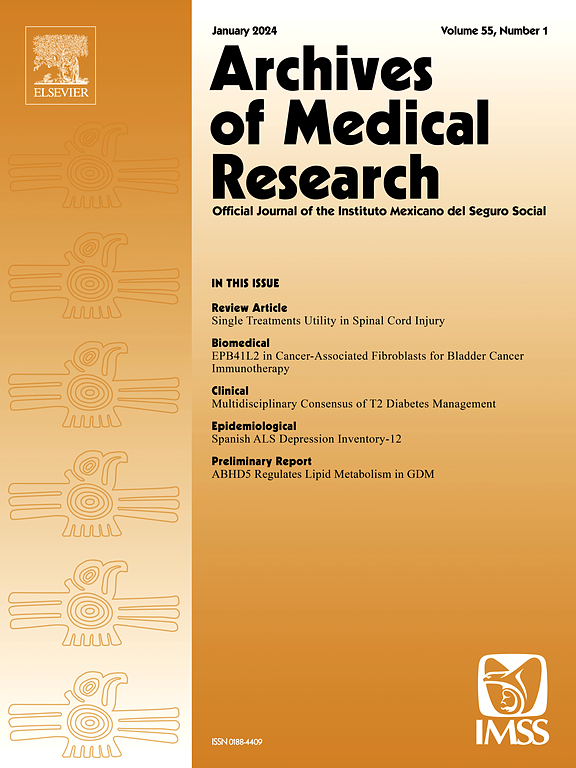细胞内半乳糖凝集素-3通过调节膜脂筏调控泡沫细胞形成和凋亡进程
IF 3.4
3区 医学
Q1 MEDICINE, RESEARCH & EXPERIMENTAL
引用次数: 0
摘要
背景:动脉粥样硬化是全球心血管疾病(CVD)死亡的主要原因,其特征是脂质代谢失调和未解决的炎症。巨噬细胞衍生泡沫细胞的形成和凋亡有助于斑块的形成和脆弱性。血清半乳糖凝集素-3 (Gal-3)水平升高与CVD风险增加相关,斑块中的Gal-3与巨噬细胞密切相关。然而,它对炎症的影响仍然存在争议。方法采用人thp -1源性巨噬细胞模拟炎性泡沫细胞,建立体外模型。通过crispr - cas9辅助敲除THP-1细胞中的LGALS3来阐明Gal-3在炎症和细胞凋亡中的功能作用。结果soxldl内化thp -1衍生泡沫细胞在脂多糖(LPS)处理下分泌显著的Gal-3,模拟CVD患者Gal-3水平升高。lps处理的泡沫细胞表现出gal -3依赖性炎症、内质网应激和细胞凋亡进展。LGALS3敲除可减少oxLDL摄取和炎症,并伴有CD36和CD14表面表达降低。这表明脂质筏结构被破坏,正如霍乱毒素B亚基识别减少和鞘脂谱改变所证实的那样。Gal-3抑制剂GB1107和TD139可减弱lps诱导的细胞因子产生。值得注意的是,由于其优越的膜通透性,只有GB1107通过部分破坏脂筏组织来抑制oxLDL的摄取。在LPS或oxLDL暴露下,GB1107进一步改变了Gal-3的核定位,表明其在炎症过程中可能具有核作用。重要的是,GB1107减少了原代人单核细胞源性巨噬细胞中的泡沫细胞形成,支持其翻译相关性。结论sgal -3调节脂质筏组织和oxLDL内化,在泡沫细胞生物学中起促炎介质作用。这些发现强调了Gal-3作为早期动脉粥样硬化的潜在治疗靶点。本文章由计算机程序翻译,如有差异,请以英文原文为准。
Intracellular Galectin-3 as a Crucial Regulator of Foam Cell Formation and Apoptosis Progression through the Modulation of Membrane Lipid Rafts
Background
Atherosclerosis, a leading cause of cardiovascular disease (CVD) mortality worldwide, is characterized by dysregulated lipid metabolism and unresolved inflammation. Macrophage-derived foam cell formation and apoptosis contribute to plaque formation and vulnerability. Elevated serum galectin-3 (Gal-3) levels are associated with increased CVD risk, and Gal-3 in plaques is strongly associated with macrophages. However, its impact on inflammation remains controversial.
Methods
An in vitro model using human THP-1-derived macrophages was established to simulate inflammatory foam cells. CRISPR-Cas9-assisted LGALS3 knockout in THP-1 cells was performed to elucidate the functional role of Gal-3 in inflammation and apoptosis.
Results
OxLDL-internalized THP-1-derived foam cells secreted significant Gal-3 upon lipopolysaccharide (LPS) treatment, mimicking elevated Gal-3 levels observed in patients with CVD. LPS-treated foam cells showed Gal-3-dependent inflammation, endoplasmic reticulum stress, and apoptosis progression. LGALS3 knockout reduced oxLDL uptake and inflammation, accompanied by decreased surface expression of CD36 and CD14. This indicates a disrupted lipid raft structure, as confirmed by reduced cholera toxin B subunit recognition and altered sphingolipid profile. Gal-3 inhibitors GB1107 and TD139 attenuated LPS-induced cytokine production. Notably, only GB1107 inhibited oxLDL uptake by partially disrupting lipid raft organization, due to its superior membrane permeability. GB1107 further altered Gal-3 nuclear localization under LPS or oxLDL exposure, suggesting a potential nuclear role during inflammation. Importantly, GB1107 reduced foam cell formation in primary human monocyte-derived macrophages, supporting its translational relevance.
Conclusions
Gal-3 modulates lipid raft organization and oxLDL internalization, acting as a pro-inflammatory mediator in foam cell biology. These findings highlight Gal-3 as a potential therapeutic target for early atherosclerosis.
求助全文
通过发布文献求助,成功后即可免费获取论文全文。
去求助
来源期刊

Archives of Medical Research
医学-医学:研究与实验
CiteScore
12.50
自引率
0.00%
发文量
84
审稿时长
28 days
期刊介绍:
Archives of Medical Research serves as a platform for publishing original peer-reviewed medical research, aiming to bridge gaps created by medical specialization. The journal covers three main categories - biomedical, clinical, and epidemiological contributions, along with review articles and preliminary communications. With an international scope, it presents the study of diseases from diverse perspectives, offering the medical community original investigations ranging from molecular biology to clinical epidemiology in a single publication.
 求助内容:
求助内容: 应助结果提醒方式:
应助结果提醒方式:


